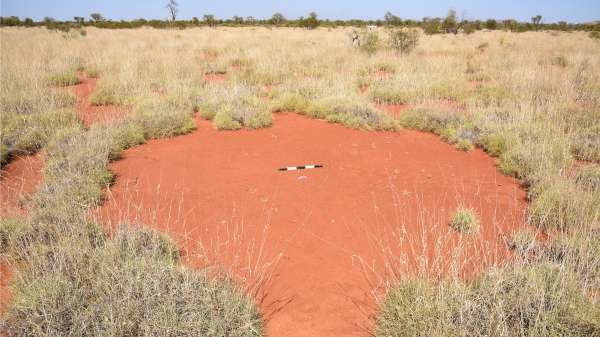A large, mature fairy circle. Australian fairy circles have mean diameters of four metres. Credit: Stephan Getzin
An extremely rare phenomenon known as fairy circles—a concept more at home in the pages of fantasy books—have sprung into the vast, arid expanse of the modern day Pilbara.
We should clarify there is no fairy magic behind these particular formations but rather circular bare patches of earth surrounded by a ring of spinifex (Triodia spp).
The phenomenon is unknown anywhere else in the world except for 10,000km away in Namibia where they earned their name for the traditional belief that fairies left the earth bare after dancing on it through the night.
While the scientific explanation for their occurrence is far less fanciful, scientists are nevertheless thrilled with the discovery and the rare line up of conditions which results in their growth.
WA environmental consultant Bronwyn Bell contacted fairy circle expert Stephan Getzin from the Helmholtz Centre for Environmental Research in Germany after reading about his work on Namibia's fairy circles.
She believed she'd seen similar growth patterns outside of Newman.
Dr Getzin and his Israelian colleague Hezi Yizhaq flew to the Australian outback in December to study the phenomenon.
The fairy circles are an example of self-organising vegetation patterns which, just like a fairy spell, need a particular concoction of ingredients to occur, Dr Getzin says.
Mother Nature tweaks conditions for magical conditions
First, Mother Nature needs to provide just the right scarcity of rainfall—any less and there would be different vegetation patterns or no vegetation—any more rainfall and there would be continuous vegetation coverage.
Mother Nature needs to sprinkle this rainfall over a flat surface, with a homogenous soil type. And she must choose an area that supports ideally no more than two grass species.
Then, abracadabra, you have a fairy circle.
"When there is not enough rainfall to sustain complete vegetation coverage these kinds of patterns occur," Dr Getzin says.
"They are only found in a very narrow climate range."
The Pilbara's fairy circles occur over an area of about 500km2, with each circle about 10m apart and are sized about four metres across.
Dr Getzin suspects the vast Australian outback may be home to more fairy circles.
He plans to return to the Pilbara to obtaining higher resolution aerial photos of the circles so he can better understand the stages of fairy circle formation after fires.
Examining the exact spacing of spinifex plants and other factors while the region recovers from fire will help us to better understand the fairy circle phenomenon, he says.
Provided by Science Network WA
This article first appeared on ScienceNetwork Western Australia a science news website based at Scitech.
























